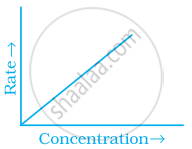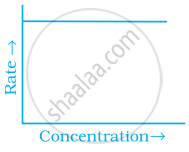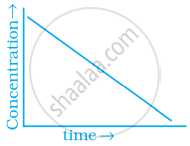Advertisements
Advertisements
Question
Match the graph given in Column I with the order of reaction given in Column II. More than one item in Column I may link to the same item of Column II.
| Column I | Column II | |
| (i) |  |
|
| (ii) |  |
(a) 1st order |
| (iii) |  |
(b) Zero-order |
| (iv) |  |
Solution
| Column I | Column II | |
| (i) |  |
(a) 1st order |
| (ii) |  |
(b) Zero-order |
| (iii) |  |
(b) Zero order |
| (iv) |  |
(a) 1st order |
Explanation:
For zero order reaction rate equation may be written as [R] = – kt + [R0]
Which denotes a straight line equation similar to y = mx + c
On transmitting (i) `([R] - [R_0])/t = - k`
`k = ([R_0] - [R])/t`
k = Rate
Rate = `k.[t]^0`
Rate `oo [t]^0`
For a first order reaction `(dx)/(dt) oo` [concentration]

∴ Graph between rate and concentration may be drawn as

`k = 2.303/t log ([R]_0)/([R])`
`(kt)/2.303 = log ([R]_0)/([R])`
`(kt)/2.303 = log[R_0] - log[R]`
\[\ce{log[R] = \underset{(Slope)}{\frac{-k}{2.303}} t + \underset{(Intercept)}{log[R]_0}}\]
APPEARS IN
RELATED QUESTIONS
What is pseudo first order reaction? Give one· example of it.
A reaction is second order with respect to a reactant. How is the rate of reaction affected if the concentration of the reactant is doubled?
How does calcination differ from roasting?
Consider a first order gas phase decomposition reaction given below :
\[\ce{A(g) -> B(g) + C(g)}\]
The initial pressure of the system before decomposition of A was pi. After lapse of time ‘t’, total pressure of the system increased by x units and became ‘pt’ The rate constant k for the reaction is given as ______.
Consider the reaction A ⇌ B. The concentration of both the reactants and the products varies exponentially with time. Which of the following figures correctly describes the change in concentration of reactants and products with time?
For a complex reaction:
(i) order of overall reaction is same as molecularity of the slowest step.
(ii) order of overall reaction is less than the molecularity of the slowest step.
(iii) order of overall reaction is greater than molecularity of the slowest step.
(iv) molecularity of the slowest step is never zero or non interger.
For a reaction A + B → products, the rate law is given by: r = `K[A]^(1/2)`. What is the order of reaction?
The rate constant for the reaction \[\ce{2H2O5 -> 4NO2 + O2}\] is 30 × 10–5 sec–1. if the rate is 204 × 10–5 mol L–1 S–1, then the concentration of N2O5 (in mol–1) is-
For a first order A → B, the reaction rate at reactant concentration of 0.01 m is found to be 2.0 × 10–5. The half-life period of reaction.
The half-life period of a. substance in a certain enzyme catalysed reaction is 138 s. The time required for the concentration of the substance to fall from 1.28 mol–1 to 0.04 mg L–1 is
